How Long Does It Take Uranus to Orbit the Sun
Key Facts & Summary
- Since ancient times it was not recognized due to its dimness and slow orbit. However, in 1781 Sir William Herschel announced its discovery being the first planet discovered with the help of a telescope.
- It was given the name Uranus, after the Greek god of the sky Ouranos.
- It is the only planet whose name is derived directly from a figure of Greek mythology.
- The mean apparent magnitude of Uranus is 5.68 with a standard deviation of 0.17, making it near the limit of naked eye visibility.
- Uranus is the seventh planet from the Sun, around 1.8 billion miles or 2.9 billion kilometers distance away.
- It has the third-largest planetary radius and fourth-largest mass in the Solar System.
- It has a radius of 25.362 kilometers or 15.759 miles, and has about 14.5 times the mass of Earth and four times its diameter – about 51.118 kilometers or 31.763 miles.
- It is on an average distance of 19.2 AU away from the Sun and currently 18.8 AU away from Earth. Its actual distance can be checked online as Uranus is constantly tracked.
- Its volume is about 63 times greater than Earth's, which means that 63 Earths can fit inside it.
- The gravity on Uranus is about 8.87 m/s² or around 86% of the surface gravity on Earth which is 9.807 m/s².
- It orbits the sun quite unusually, being the only planet whose equator is nearly at a right angle to its orbit, with a tilt of 97.77 degrees. Because of this, it rotates in the opposite direction than most planets, from East to West. Venus also does this but Uranus is the only known planet to rotate on its side.
- It takes Uranus 84 years to complete an orbit of the Sun, the longest from all the planets in the solar system.
- It also has the shortest day. One rotation on Uranus takes about 17 hours.
- Uranus has the coldest planetary atmosphere in the solar system, -224 degrees Celsius;-371 degrees Fahrenheit.
- Uranus and Neptune share similar composition, both have bulk chemical compositions which differ from that of the larger gas giants Jupiter and Saturn. Because of this Uranus and Neptune are classified as ice giants rather than gas giants, for easier distinction.
- Uranus has a similar atmosphere to Jupiter and Saturn in its primary composition of hydrogen and helium yet, it contains more "ices" such as water, ammonia, methane and traces of other hydrocarbons.
- Though it appears featureless, without the cloud bands or storms associated with the other giant planets, it does have complex, layered cloud structure with water thought to make up the lowest clouds and methane the uppermost layer of clouds.
- Through analysis, the interior of Uranus has been stated to be made up primarily of ices and rock.
- Uranus has 13 known rings around it. The innermost rings are narrow and dark, and its outermost rings are brightly colored.
- Like the other gas giants, it also has a magnetosphere and many moons. Until now, 27 moons have been discovered orbiting Uranus. They were named after characters from the works of William Shakespeare and Alexander Pope.
- Uranus has been visited only once by a spacecraft: Voyager 2.
Though it is visible to the naked eye, Uranus escaped clear classification for decades. Generally mistaken for a star, it is speculated that Hipparchos might have recorded it first in 128 BC in his star catalogue. Later it was incorporated into Ptolemy's Almagest.
However, the earliest definite sighting was in 1690. John Flamsteed observed it six times, cataloguing it as 34 Tauri. Later it was observed for about fourteen-times by Charles Le Monnier between 1750 and 1769. The man who finally solved this elusive object was William Herschel who observed it on 13 March 1781 with a telescope.

Although he first classified it as a comet, soon after reporting his discovery to other famous astronomers, it was concluded that in fact it was a planet. By 1783, Herschel acknowledged this and later was rewarded by the then king of England George III, on the condition that he moved to Windsor, in order for the royal family to also see it.
However, another problem was raised now, the name. It took about 70 years after the planet was discovered for astronomers to arrive at a consensus. Initially Herschel wanted to honor the king and name the new planet Georgium Sidus or "Georgian Planet." This decision was not popular outside Britain, and alternatives were proposed such as Herschel's own name, to even that of Neptune who wasn't by this time discovered. Neptune was quite popular since it would have honored the British Royal Naval victories in the course of the American Revolutionary War, but it was soon dropped.
In 1782 Johann Bode proposed the name Uranus, the Latinized version of the Greek god of the sky, Ouranos. His argument was that the new planet would stand out from the others if it wasn't following the mythology. Just as Saturn was the father of Jupiter, the new planet should be named after the father of Saturn. In 1789, an acquaintance of Bode, Martin Klaproth named his newly discovered element uranium in support of Bode's choice. The name became universal in 1850.
In other languages such as Chinese, Japanese, Korean and Vietnamese, Uranus is translated as "sky king star." Its official name in Thai is Dao Yurenat, in Mongolian Tengeriin Van meaning "King of the Sky" but in Hawaiian its name is Hele'ekala, a loanword for the discoverer of Uranus, Herschel.
Formation
Through simulations after the Nice model, it has been suggested that both Uranus and Neptune formed closer to the sun and later drifted away. It is hypothesized that the Solar System formed from a giant rotating ball of gas and dust known as the pre-solar nebula. Much of it formed the Sun while more of its dust went on and merged to create the first proto-planets. As they grew, some accreted enough matter for their gravity to hold unto the nebula's leftover gas. Estimates suggest the creation to have taken place about 4.5 billion years ago, and the drifting about 4 billion.
Distance, Size and Mass
Since its discovery, the planet has shifted it 1° west every 72 years however, its average distance from the sun still remains about 20 AU or 2 billion kilometers – 2 billion miles. The difference between its furthest and closest point from the sun is about 1.8 AU, larger than that of any other planet with the exception of the dwarf planet Pluto.
Though its mass is roughly 14.5 times that of Earth, it is the least massive compared to the other giant planets, having a mass of 8.681 × 10^25 kg. However, its diameter is slightly larger than that of Neptune, and it's about four times that of Earth: about 51.118 kilometers or 31.763 miles.
The density of Uranus 1.27 g/cm3 makes it the second least dense planet, after Saturn. This value indicates that it is made primarily of various ices such as water, ammonia, and methane. The mass of its interior is however debatable, it is speculated to be around 9.3 and 13.5 Earth masses.
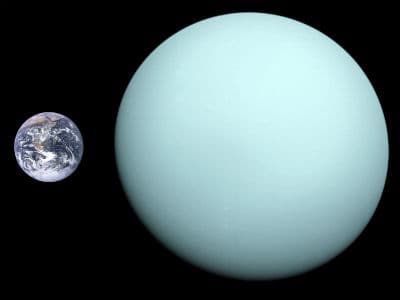
It has the third largest planetary radius: 25.362 kilometers or 15.759 miles, and its volume is about 63 times greater than Earth's, which means that 63 Earths can fit inside it.
Orbit and Rotation
It takes Uranus about 7 years to pass through each zodiac constellation, and a total of 84 years to make a complete trip around the sun. Its interesting orbing caught the attention of astronomers because the planet escaped its predicted location, and thus it led to the discovery of the last planet in 1846 that would later be called Neptune.
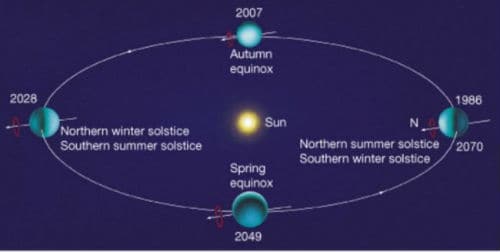
The interior rotation of Uranus is completed in about 17 hours, 14 minutes, and as in the case of all the gas giants its upper atmosphere experiences strong winds in the direction of rotation thus making a full rotation faster, in about 14 hours.
Axial tilt
The axis of rotation is approximately parallel with the plane of the Solar System, with a tilt of 97.77°. This feature gives Uranus completely different seasonal changes unlike those of other planets.
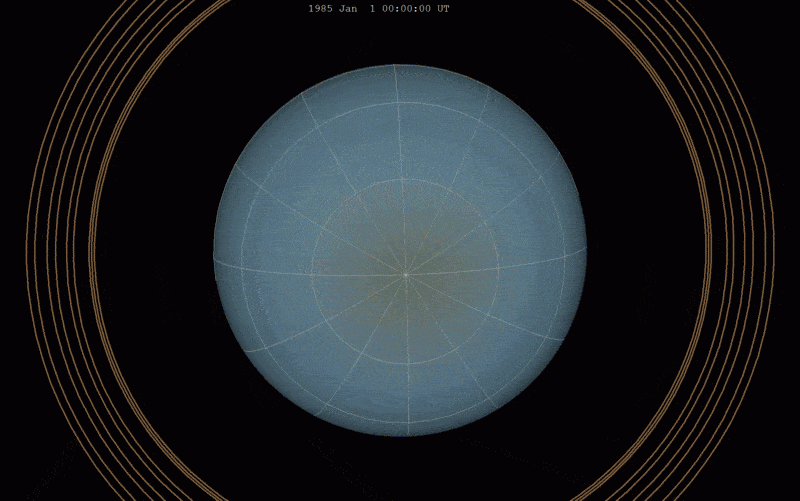
Near the solstice, one pole faces the sun continuously while the other is covered in complete darkness. At the other side of Uranus's orbit the orientation of the poles towards the Sun is reversed with each pole getting around 42 years of continuous light, and the other of darkness. Neat the time of the equinoxes, the Sun faces the equator of Uranus giving a period of day-night cycles similar to those seen on most of the other planets.
Uranus is hotter at its equator than at its poles. We do not know why this is so, nor do we know exactly why Uranus has such an unusual axial tilt. However, speculations suggest that Uranus suffered about 3 to 4 billion years ago, a collision with an Earth-sized protoplanet while the solar system was forming.
Structure
The standard model structure of Uranus consists of three layers: a rocky silicate/iron-nickel core in the center, an icy mantle in the middle and an outer gaseous hydrogen/helium envelope.
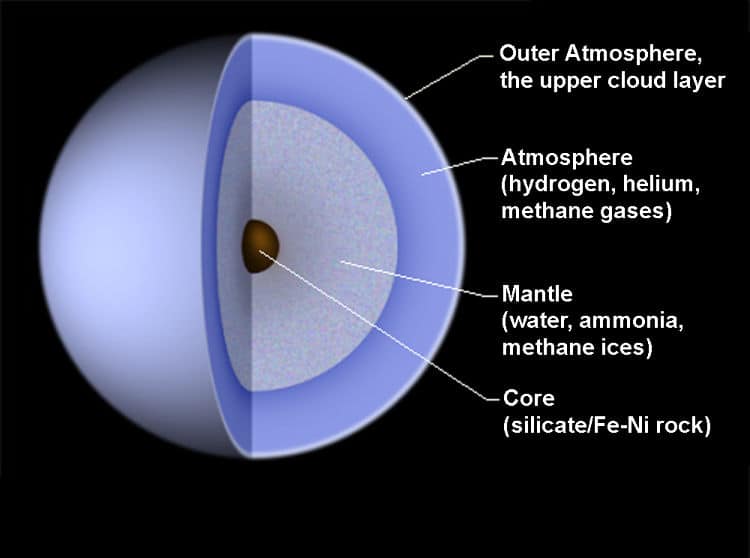
The core's mass is estimated to be about 0.55% Earth masses with a radius less than 20% of the whole of Uranus. The mantle comprises its bulk, with around 13.4 Earth masses. The upper atmosphere is relatively insubstantial, weighing about 0.5 Earth masses and expanding for the last 20% of Uranus's radius. The core density is around 9 g/cm3, with a pressure in the middle of about 8 million bars, and a temperature of about 5.000 K. What is referred to as the ice mantle is not in fact composed of ice in the conventional sense, but of a hot and dense fluid consisting of water, ammonia and other volatiles.
It is believed that the extreme temperatures and pressure condense carbon atoms into crystals of diamond. It is thought that these rainfalls of solid diamonds also occur on Jupiter, Saturn and Neptune. The prime factor that justifies the difference between Uranus and Neptune to Saturn and Jupiter is the fact that ice dominates over gases, hence the separate classification as "ice giants". Ice giants are believed to have liquid oceans and gas giants about 85% just gas.
Uranus has no solid surface because of its fluid interior structure. The atmosphere comprised of gases gradually transitions into the internal liquid layers. But for easier understanding, a revolving oblate spheroid set at the point at which atmospheric pressure equals 1 bar is conditionally designated as a "surface".
Though it is the coldest planet in the solar system, it is not know why. Something prevents the heat of Uranus's core from reaching the surface. It is believed that a form of barrier exists in the planets upper layers that stop the heat. Another theory suggests that after a massive collision, Uranus expelled most of its primordial heat, leaving its core temperature depleted.
Atmosphere
Uranus lacks a well-defined solid surface in its interior. However, the outermost part of the planet enveloped by gasses that is accessible to remote sensing is called its atmosphere. Remote-sensing capability extends down to roughly 300 kilometers or 186 miles below the 1 bar level, with a corresponding pressure of 100 bars and a temperature of 320 K (47 °C; 116 °F). Its atmosphere is mostly consistent in molecular hydrogen, helium, methane, ammonia, water, hydrogen sulfide, various hydrocarbons and water vapor, carbon monoxide and carbon dioxide possibly due to an external source such as in falling dust and comets.
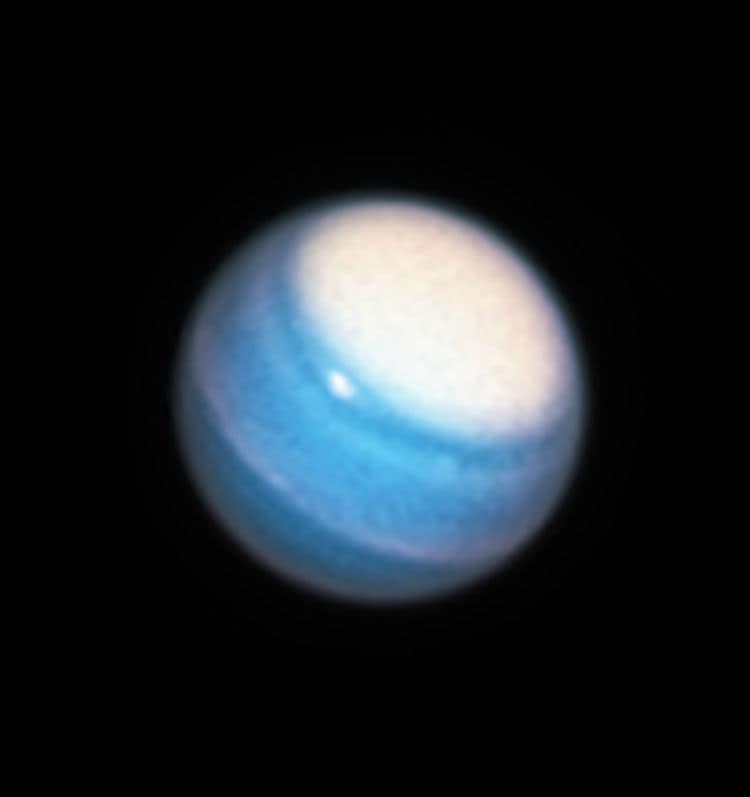
Uranus has no mesosphere, but its atmosphere can be divided into three layers:
* Troposphere, between altitudes of -300 and 50 km (-186 and 31 mi), with pressures from 100 to 0.1 bar. It is the lowest and densest part of the atmosphere, the temperature decreases with altitude. It falls from approximately 320 K (47 °C; 116 °F) at the base of the nominal troposphere at −300 km or 186 miles to 53 K (−220 °C; −364 °F) at 50 km or 31 miles. The troposphere is thought to have highly complex cloud structures and is a dynamic part of the atmosphere, exhibiting strong winds, bright clouds and seasonal changes.
* Stratosphere, spanning altitudes between 50 and 4,000 km (31 and 2,485 mi), with pressures between 0.1 and 10−10 bar. Temperatures gradually increase with altitude from 53 K (−220 °C; −364 °F) in the boundary of the troposphere to between 800 and 850 K (527 and 577 °C; 980 and 1,070 °F) at the base of the thermosphere. The heating is caused by absorption of solar UV and IR radiation by methane and other hydrocarbons.

* Thermosphere, extending from 4,000 km to 50,000 km (2,485 and 31,068 mi). It's the outermost layer of the atmosphere and corona, with a uniform temperature around 800 to 850 K.
Magnetosphere
The magnetic field of Uranus is peculiar, it does not originate from its geometric center, and it is tilted at 59° from the axis of rotation. The magnetic pole is shifted from the center towards the south rotational pole by as much as one third of the planetary radius.
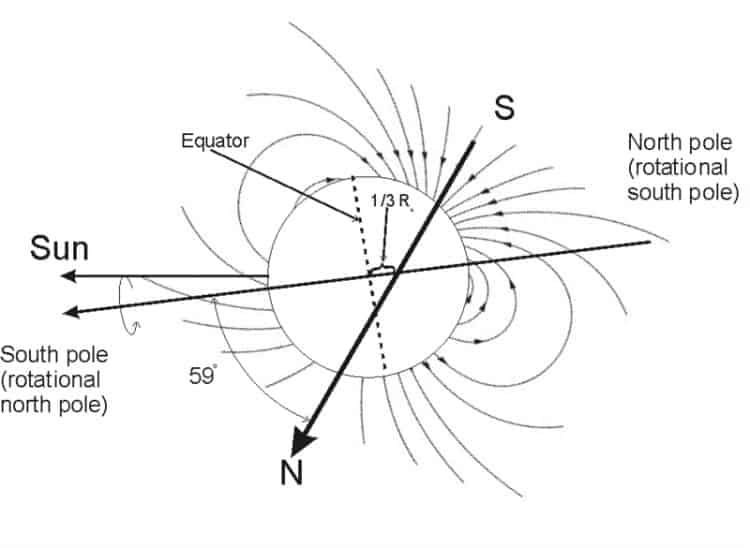
This asymmetric magnetosphere results in a magnetic field strength on the surface in the southern hemisphere of about 0.1 gauss or 10 µT, while in the northern hemisphere it can be as high as 1.1 gauss or 110 µT. The average field at the "surface" is 0.23 gauss or 23 µT. Studies of the date from the spacecraft Voyager 2, suggest that the asymmetry causes Uranus's magnetosphere to connect with the solar wind once a Uranian day, opening the planet to the Sun's particles.
The dipole moment of Uranus is 50 times that of Earth. It is believed that this is a common feature of ice giants since Neptune also has a similarly displaced and tilted magnetic field.
A possible explanation of this peculiar magnetosphere alignment may be due to Uranus's oceans of liquid diamond in the interior that would deter the magnetic field. Regardless, the other aspects of the magnetosphere are similar to other planets but overall, the structure is different from that of Jupiter and more similar to that of Saturn.
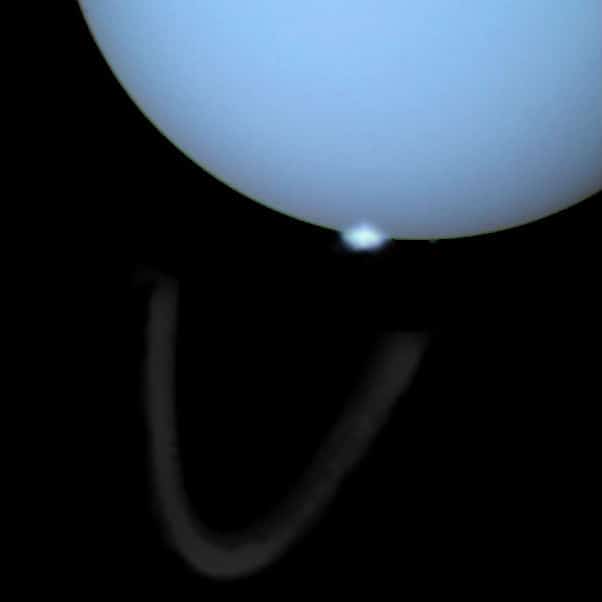
The aurorae of Uranus are relatively well developed. They are seen as bright arcs around both magnetic poles but they seem insignificant given the energy balance of the planetary thermosphere.
Climate
Uranus's atmosphere appears quite bland in comparison to the other giant planets, especially to Neptune whom it otherwise closely resembles.
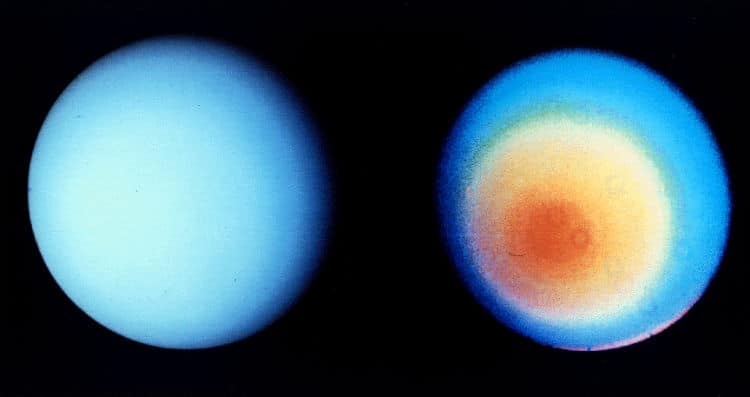
A total of 10 cloud features were observed on the entire planet by the Voyager 2 spacecraft when it flew by Uranus in 1986. One explanation for this great lack of features is that the internal heat appears markedly lower than that of the other giant planets.
But all of this changed when the Hubble Space Telescope observed the ice giant. Analysis revealed that the planet had a dynamic weather, characterized by storms half as big as the United States or even twice in size.
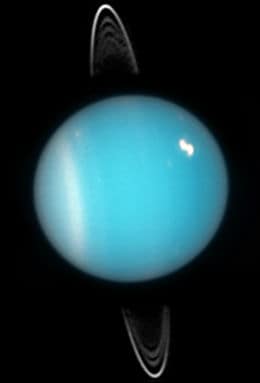
In 2006 a dark cloud was spotted on the planet. This storm was gigantic, two thirds the size of the United States. The average temperatures of the clouds were -315 degrees Fahrenheit. The wind speeds can reach up to 560 miles or 900 kilometers per hour blowing in the retrograde at the equator, in the reverse direction of the planet's rotation.
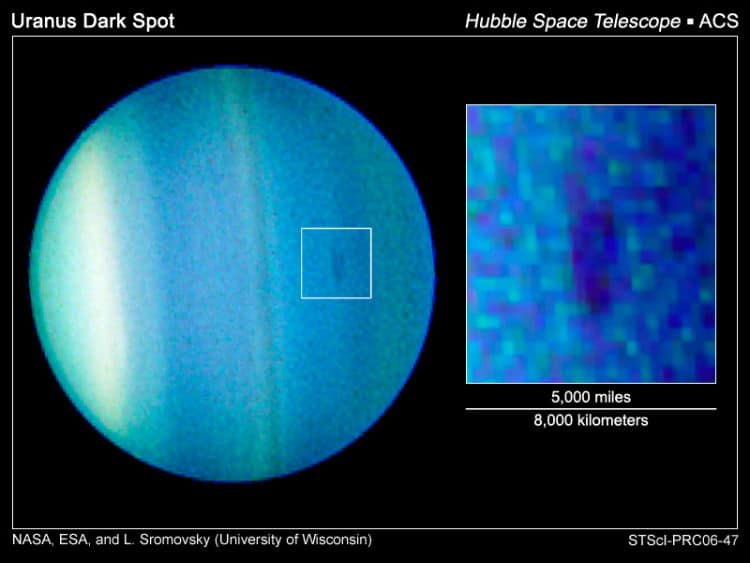
Moons
Like other giant planets Uranus has many moons. Until now 27 satellites have been discovered, and were named after characters from the works of Shakespeare and Alexander Pope. Although the Uranian satellite system is the least massive among those of the giant planets. There are five main satellites that stand out: Miranda, Ariel, Umbriel, Titania and Oberon.

However they are small, even with the combined masses of all five they would still be less than half of Triton – the largest moon of Neptune. Every single one of them has a smaller surface area than the continent of Australia and most of them lack atmosphere.
Miranda
Miranda is a spherical moon and one of the strangest places in the solar system. It has a similar surface area to Chile: 700.000 km2 while Chile has 750.000 km2. The landscape is very deformed with strange and hard to explain patterns occurring throughout the whole surface.
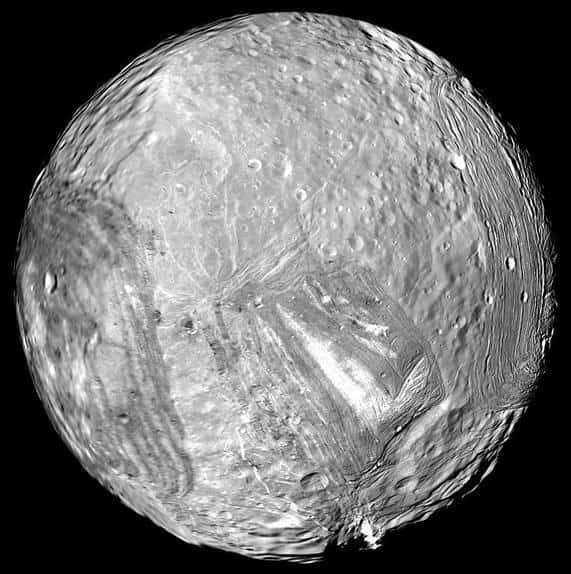
It is the smallest and innermost satellite of Uranus. It was discovered in 1948 and named after Miranda from Shakespeare's play The Tempest. It has a diameter of 470 kilometers or 292 miles, and it's one of the smallest yet closely observed objects in the Solar System.
It shares Uranus's extreme seasonal cycle for Miranda's orbit is perpendicular to the ecliptic. Its highest cliff named Verona Rupes, is a 20 kilometer-high scarp that is the highest cliff in the solar system. Canyons and mountains are also a common feature of Miranda which is peculiar since there is no geological activity.
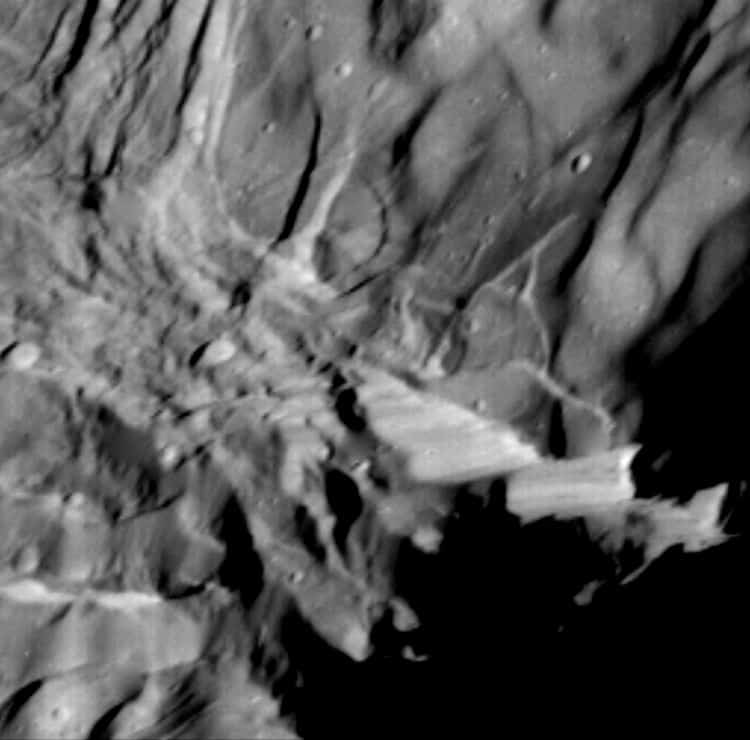
Miranda and Uranus are 130.000 kilometers or 80.700 miles away from each other, three times closer than the moon is to Earth. Miranda has a low density of 1.2 g/cm3 it is the least dense satellite of the five. This suggests that it is made up of 60% water-ice. It is thought that in the past the satellite was shattered by a giant object and the remaining pieces were pulled together by gravity thus forming it as it is now.
Ariel
It is the fourth largest of the known moons of Uranus, the second smallest after Miranda, and it orbits and rotates in the equatorial plane of its parent planet. This is almost perpendicular to the orbit of Uranus thus resulting in extreme seasonal cycles. It has an estimated diameter of 1,157 kilometers or 718 miles.
Discovered in 1851 by William Lassell and named after two characters: the sky spirit in Alexander Pope's The Rape of the Lock and the spirit who serves Prospero in Shakespeare's The Tempest.

It ranks 14th among the 19 smallest known spherical moons in the Solar System. It is estimated to be composed out of equal parts of rock and ice. It shows more geological activity than the other moons most likely due to tidal heating. It is also believed to have formed from an accretion disc that surrounded the planet shortly after its formation. Its inner core is comprised of rock surrounded by an ice mantle. Its mass is equivalent in magnitude to Earth's hydrosphere. It is the second closest to Uranus, orbiting at the distance of about 190.000 kilometers or 118.060 miles.
It completes an orbit in 2.5 days with one side always facing the planet. Its orbit lies completely in Uranus's magnetosphere this bombardment may lead to the darkening of the trailing hemispheres observed for all Uranian moons. It may have the third largest mass with a density of 1.66 g/cm3.
Umbriel
Also discovered by William Lassell in 1851, the moon consists mainly of ice and only a fraction of rock. It has the darkest surface of the Uranian moons and appears to have been shaped by impacts.
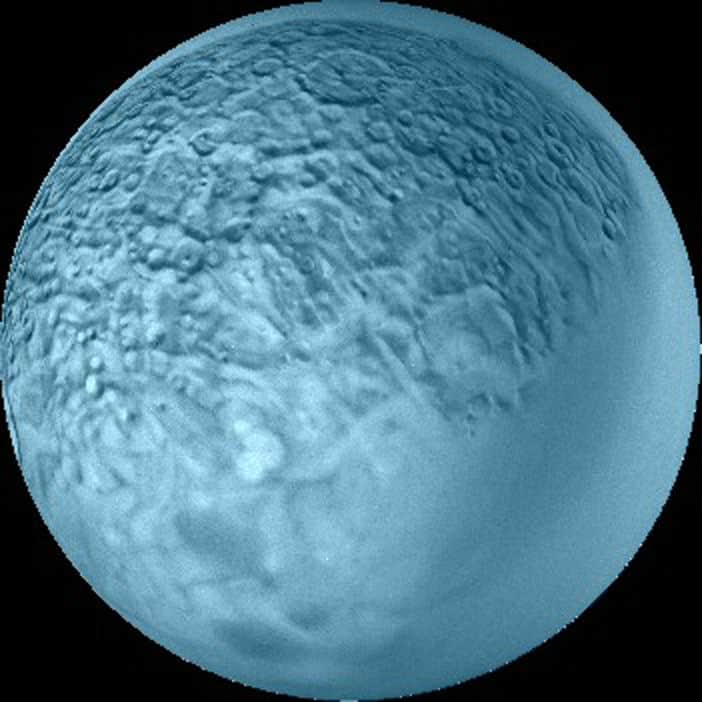
It is the second most heavily cratered Uranian moon after Oberon, with craters reaching up to 210 kilometers or 130 miles. A prominent surface feature is a ring of bright material on the floor of the Wunda crater. This moon was named after the dusky melancholy sprite in Alexander Pope's The Rape of the Lock.
The name suggests the Latin word umbra, meaning shadow. It is the third farthest moon orbiting the planet at a distance of 266.000 kilometers or 165.000 miles. Its orbital period is the same as its rotational period, 4.1 Earth days. This means that Umbriel also has one side always facing Uranus. Its orbit is also captured in Uranus's magnetosphere. It has a density of 1.39 g/cm3 and it reflects less than half as much light as Ariel. It has an estimated diameter of 1,169 kilometers or 726 miles.
Titania
The largest moon of Uranus, and the eight largest moon in the Solar System with a diameter of 1,578 kilometers or 981 miles. It was discovered in 1787 by William Herschel, the discoverer of Uranus. It was named after the queen of the fairies in Shakespeare's - A Midsummer Night's Dream.
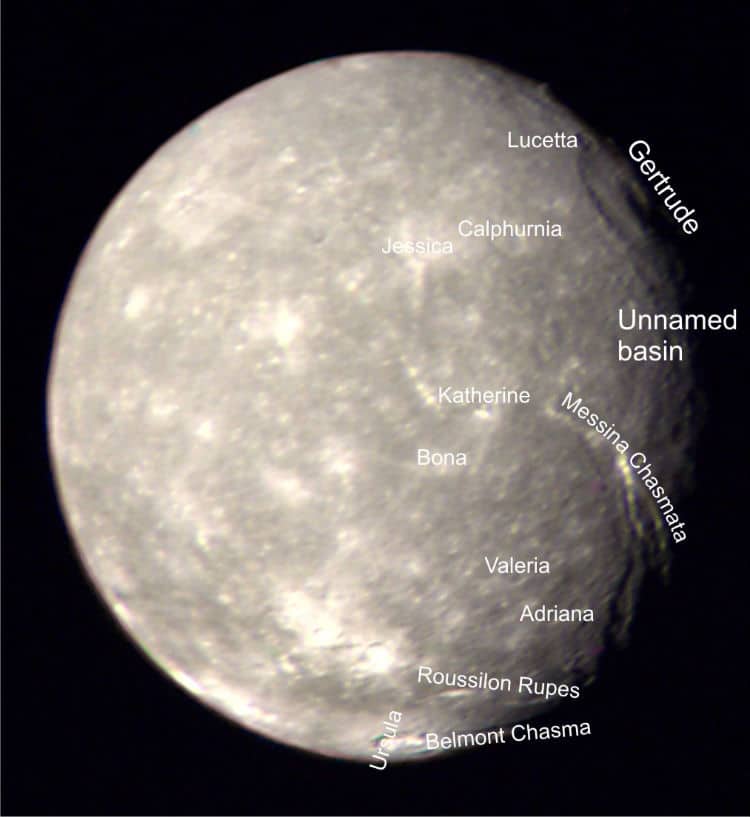
It has about half the radius of Earth's moon about 788.9 kilometers or 490 miles. In 2005 infrared spectroscopy revealed the presence of water ice as well as frozen carbon dioxide on its surface. It has a density of 1.71 g/cm³ that indicates an equal consistency of water ice and dense non-ice components. It is the most massive of the Uranian moons, and the 8th most massive moon in the Solar System.
Like the three aforementioned moons its orbit is also caught in Uranus's magnetosphere. It orbits Uranus at a distance of approximately 436,000 kilometers or 271,000 miles being the second farthest from the planet among the other four moons.
An orbital period is completed in 8.7 days. It is also tidally locked satellite, having just one side of it permanently facing Uranus. Its surface is cut by a system of enormous canyons, scarps and it appears a bit reddish. Numerous impact craters can reach up to 326 kilometers or 203 miles in diameter but it is less heavily cratered than Oberon.
Oberon
Oberon is the outermost major moon of Uranus. It was discovered in 1787 by William Herschel who also discovered Titania. It is the second-largest and second most massive of the five major Uranian moons.
Also the ninth most massive moon in the Solar System, Oberon was named after the mythical king of the fairies in Shakespeare's – A Midsummer Night's Dream.
While the other moons orbit inside Uranus's magnetosphere, Oberon's orbit lies partially outside. Its surface is dark and a bit red in color, covered by asteroid and comet impacts with craters reaching up to 210 kilometers or 130 miles in diameter.
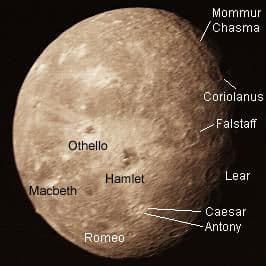
Oberon can be seen from Earth with a relatively good amateur telescope. It orbits around Uranus at a distance of about 584.000 kilometers or 362.880 miles being the furthest moon, and completing a cycle in about 13.5 days. Like the other Uranian moons it also has one side permanently facing its parent planet.
The difference between it and the other planets is that Oberon spends the majority of its orbit outside Uranus's magnetosphere, and as a result it is directly hit by solar wind. Once every 42 years during Uranus's equinox, and its equatorial plane intersects with Earth, mutual occultation occurs between the Uranian moons.
Oberon has a density of 1.63 g/cm³. This is higher than the typical density of Saturn's satellites. Titania also has this characteristic. Spectroscopic observations have revealed the presence of crystalline water ice on the surface. It is speculated that Oberon may possess a liquid ocean layer at the core-mantle boundary. Oberon is the most reddish Uranian moon, and the most heavily cratered implying that it has the oldest surface among the satellites.
Planetary Rings
Uranus has thirteen distinct ring systems thought to have formed about 600 million years ago from the collision of possible other moons or big objects. The rings around Uranus are unique since they aren't bright like the ones of Saturn. With this low albedo they appear dark as charcoal and another unique feature is that they are extremely narrow. The widest of the rings is called the epsilon ring, spreading from 20 to 100 kilometers wide.
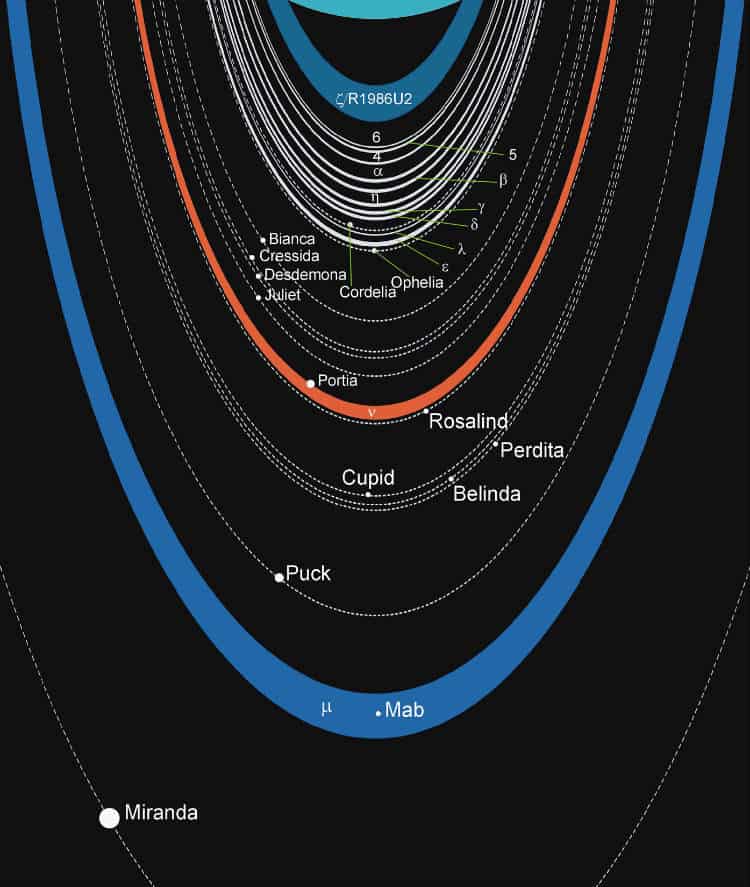
In 1978, nine distinct rings were discovered, two more in 1986 and by 2003-2005 an additional two. Most of them are opaque and consist of large bodies 0.2 – 20m in diameter made up of water ice with the addition of some dark radiation-processed organics. Their radii range extends from about 38.000 kilometers to 98.000 or 23.612 to 60.894 miles.
Life Habitability
Since it doesn't have a true surface but rather swirling fluids it is not conducive to life as we know it.
Future plans for Uranus
With new technologies coming up, Uranus is definitely a target for future studies and some missions have already been announced though it remains to be seen if they will take place.
Did you know?
- In 2033, Uranus will complete its third orbit around the sun since its discovery in 1781. The planet returned to the point of its discovery twice since then, in 1862 and 1943, one day later each time.
- Because of its brightness, the planet can be seen in urban conditions on a good night, even without binoculars.
- Though it is 20 times further away from the Sun than Earth, Uranus's intensity of light is about 1/400 that of Earth.
- Uranus is Neptune's near twin in size and composition.
- The third most abundant component of Uranus's atmosphere is methane. Methane has prominent absorption bands in the visible and near-infrared, making Uranus aquamarine or cyan in color.
- Between 2013 - 2100, the closest approach of Uranus to Earth will happen in 2051 at a distance of 17.2 AU.
Sources:
[1.] Wikipedia
[2.] NASA
Image source:
- https://en.wikipedia.org/wiki/Uranus#/media/File:Uranus2.jpg
- https://upload.wikimedia.org/wikipedia/commons/9/95/Uranus%2C_Earth_size_comparison_2.jpg
- https://en.es-static.us/upl/2015/01/uranus-seasons-orbit-lg-e1485185411910.jpg
- https://en.wikipedia.org/wiki/Uranus#/media/File:Uranus_orientation_1985-2030.gif
- https://upload.wikimedia.org/wikipedia/commons/f/fe/Uranus-intern-en.png
- https://en.wikipedia.org/wiki/Uranus#/media/File:Adding_to_Uranus's_legacy.tif
- https://en.wikipedia.org/wiki/Uranus#/media/File:Tropospheric_profile_Uranus_new.svg
- https://en.wikipedia.org/wiki/Uranus#/media/File:Uranian_Magnetic_field.gif
- https://en.wikipedia.org/wiki/Uranus#/media/File:Uranuslight.jpg
- https://en.wikipedia.org/wiki/Uranus#/media/File:Uranuscolour.png
- https://en.wikipedia.org/wiki/Uranus#/media/File:Uranus_clouds.jpg
- https://en.wikipedia.org/wiki/Uranus#/media/File:Uranus_Dark_spot.jpg
- https://en.wikipedia.org/wiki/Uranus#/media/File:Uranian_moon_montage.jpg
- https://en.wikipedia.org/wiki/Miranda_(moon)#/media/File:PIA18185_Miranda's_Icy_Face.jpg
- https://en.wikipedia.org/wiki/Miranda_(moon)#/media/File:Miranda_scarp.jpg
- https://en.wikipedia.org/wiki/Ariel_(moon)#/media/File:Ariel_(moon).jpg
- https://en.wikipedia.org/wiki/Umbriel_(moon)#/media/File:Umbriel_usgsx2.jpg
- https://en.wikipedia.org/wiki/Titania_(moon)#/media/File:Titania_(moon)_labeled.jpg
- https://en.wikipedia.org/wiki/Oberon_(moon)#/media/File:Oberon-NASA_names_en.png
- https://en.wikipedia.org/wiki/Uranus#/media/File:Uranian_rings_scheme.png
How Long Does It Take Uranus to Orbit the Sun
Source: https://nineplanets.org/uranus/